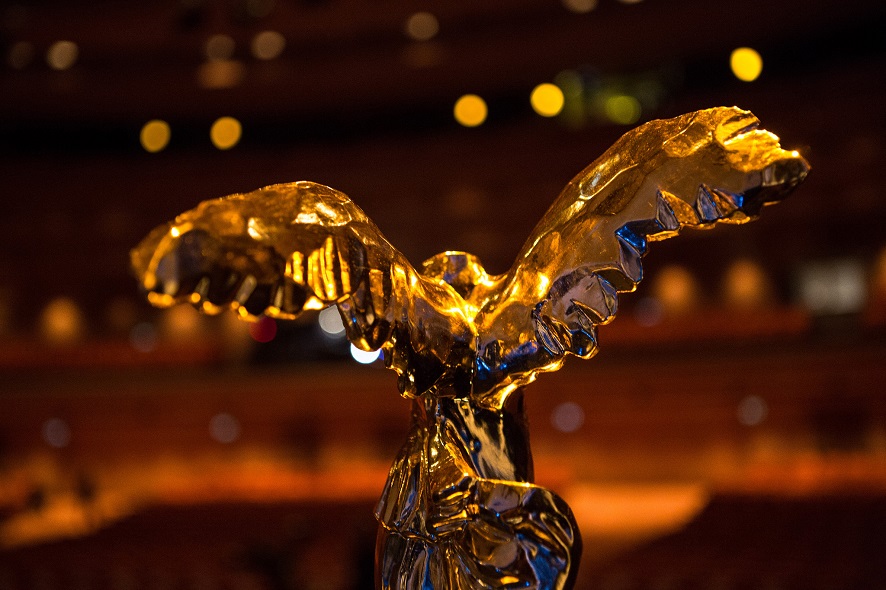Every year, it’s one of the most important events in media art: When the winners of the long-standing Prix Ars Electronica are announced, creative minds from all over the world watch closely. This year, it will be even a little more exciting than usually: In addition to the existing Computer Animation, Digital Musics & Sound Art and U19 – CREATE YOUR WORLD categories, entries can also be submitted in the new Artificial Intelligence & Life Art category for the very first time in 2019 (from January 16, 2019 to March 11, 2019, here).
“This is the avant-garde of our time,” says Gerfried Stocker, Artistic Director of Ars Electronica, describing the work in these two areas. In an interview, he and Emiko Ogawa, director of Prix Ars Electronica, reveal what else is concealed behind the new category and why is exactly the right moment to look in the direction of AI and Life Arts.

Credit: Tom Mesic
This year, there is a new category at Prix Ars Electronica: “Artificial Intelligence & Life Art”. Why did you see the need for the introduction of these two fields to Prix Ars Electronica now?
Gerfried Stocker: Well, for one, Artificial Intelligence has become a very exciting area for artistic exploration. It is a topic that, because of the many implications that it has, is highly relevant for society, for cultural and artistic intervention. The new category looks at the artistic experiments and work with this new technology, but emphasizing in particular the importance of artistic engagement and intervention in the larger field of development or influence that AI has on our society and culture. Even if we might consider it a hype, looking at the huge attention that it gets at the moment, AI really is a game changer. For technical reasons, but I think even more so because it immediately addresses and reaches out for the attention of a much wider audience than any other digital technology before. This is why artistic work within this field is tremendously important, for art and for society.
The same goes for what we summarized with the term Life Art, encompassing all those artistic works, experiments and endeavors that are engaging in the fields of biotechnology, synthetic technology, and genetic engineering. Almost every day we get exciting, often also terrifying news of how genetic engineering is progressing, whether it is in the field of extremely interesting research that allows us to get a completely new picture of the way how humanity started to exist and spread over the planet, or whether it is the terrifying news of genetically modified babies, where at the end we don’t really know if it’s just a media hype or really happening. What all these things show is that these are sciences and technologies that deeply concern humanity, that deeply concern society, that deeply concern culture. Artists working in this field are pioneers. This is the avant-garde of our time. And this is what we want to single out and celebrate: The role of artists, engaging in these highly relevant frontiers of scientific and technological developments.
Both of these areas are very touchy subjects, ethics and morality play a big role. Which added value does the artist’s perspective bring to the table?
Emiko Ogawa: Life Art is a good example for the kind of new field that we want to discuss with artists. I believe that in this area, we can really try to discuss and make it approachable. We want to think about the impact of this technology in an artistic way, together with artists, but also together with other citizens. As with every cutting-edge technology, it’s not easy to understand what the impact will be for our lives or for the future of humanity itself. Artists are sensitive to these topics, they are pioneers, and they are trying out these cutting-edge technologies and applying them to real life. Actually, it doesn’t even have to be cutting-edge – they could just be working with new ways of using existing technologies. This creates a bridge for other people. It helps us understand the technology, makes us think about how humanity will look like or how we want to live in the future.
Gerfried Stocker: I also think it’s important in this context to state that of course, scientists working in these fields, whether it’s genetic engineering or bio-technology or also Artificial Intelligence, have a very high ethical and moral standard and concern. It’s not like we need artists to be the ethical apostles of our society.
Nevertheless – the point is when you work as a scientist, your concern is and has to be scientific advancement. As an artist, you have a different focus that addresses human aspects, cultural aspects, socio-political aspects. What artists are doing when they engage in these technologies and sciences is that put their projects out of the context of the laboratories and the research institutes and into the context of galleries, concerts, festivals, public spaces. They, in an exemplary way, show us what happens when you take these sciences, these technologies out of the laboratory. Usually in the early development of technologies and sciences, we all tend to see them inside of science and research, which is a protected space, but also something we can quite easily ignore. But the moment that artists are taking it out of this context, they, in a certain way, prepare us or make us aware, that at one time or another all these technologies, all these sciences, will leave these protected and safe spaces of research, science, and development and will become part of our daily lives. So this is in a very pragmatic way one of the visionary pioneering functions that art has. What art is doing is to kick us into direct confrontation with all the meaning and impact that these technologies can have. This is an effect that artistic work has beyond the artistic environment, it’s an impact that goes far beyond what the artistic aspect of it is.
This seems especially interesting since these two fields, most of all AI, are often discussed as being black boxes, the general idea being: You don’t understand what’s happening inside, and also, you’re okay with it.
Gerfried Stocker: You know, the word “Black Box” even sounds pretty nice, actually. The next step is that these technologies are considered magic, the next worse step is that they are demonic. This way, we create a confrontation between society, individuals and this technology that is the wrong type of confrontation. There is a lot of critical, dangerous potential in this development. We have to make sure that we are, so to say, fighting the right enemy: The moment we put these technologies away in a sort of “magical black box demon”, we are not able to fight the right problems in the right place any more. We have to critically look at these technological developments, not because they are demons we don’t understand and whom we are afraid of – but because of the impacts they will have on society. We have to approach them in a competent, experienced, empowered way, even if we are not scientists. This is a dilemma, because of course we don’t understand the scientific principles and the technological processes, whether it’s AI or Life Art. But they concern us!
This is where it’s interesting, this is where art can intermediate, between the society and technology, without forcing people to study the digital or biological bases in depth. When it comes to Life Art, the term provocative is very soon on the table. Yes, I think it is provoking – but in the best way of it! Because it is thought-provoking. It means you are confronted with these works of art and you almost have no chance to not think about the implications any more. This is bridging the distance we can so easily build up to science. This is the strength of art.
Emiko Ogawa: Surprisingly, the speed in which technological developments spill over from the science and research are to our everyday lives is getting faster and faster. We only need to look at the past 20 years to see this, be it with genetically modifying food or plants or self-driving cars, to name just some examples. Of course it is being discussed that they are provocative, as are the ethical issues of course, but more than this, we are seeing a very special moment where these technologies – and artworks using them – are becoming normal. It’s an amazing way to think about technology! There is Alexa in our home, we have self-driving cars on the street, all these developments are coming to us. And they are coming to us as services.
Usually we take service because they are comfortable, not to make us think. We, as consumers, might just use these technologies because it’s easy, but we might neglect to think about ethical issues or other really important factors for us as humans. So it’s important that artists show us this moment: Yes, these technologies are nice, but there are a few things to consider. We humans might just follow a service without thinking, when in reality, how our society develops should be considered by all of us.
Gerfried Stocker: Art is the second opinion for future developments. Like with any difficult decision we have to make, in particular medical decisions, we want to have a second opinion. Usually we accept and appreciate the expertise of people where we get the first opinion, but we have learned that a second opinion is important because we have to look at difficult and important things from different directions. And I think what art is providing to society is a second opinion to questions relating to future developments.
Besides this gap between the individual and society, isn’t there also one between the public and the private? Most AI developments for example are driven by private companies and thus economically motivated…
Gerfried Stocker: This notion of what has been considered public in history, in recent history even, is eroding. As are the appreciation and value that we give it. It is not something that represents the whole society any more, where the interests of all are represented. This is mainly because of strong success stories of private companies, of capitalism, basically of the processes we have seen since the breakdown of the former Soviet Union and the end of the Cold War. There is a continuous race between the interests of private, profit-driven companies, dominating developments.
And still, all of this has even been overshadowed by the complete distortion and scrambling of the notions of public and private, of the idea of individual life, with all this exposure of what used to be private in a globalized, interconnected world. I think this is one of the big crises that we see at the moment on a global scale, in our societies, in our democracies. How do we establish trust in the public? This is considering public as the spheres that are representing everybody of us, the whole of society. How do we establish value and appreciation? How do we invent the mechanisms and the institutions that can exert this common interest in future developments?
There has been some movement here in recent years, we saw some very significant moments like when Mark Zuckerberg had to justify his and his company’s actions in front of Congress and Senate, which represent the public in a very traditional sense of the word. Still, we cannot just go back to the way how public life and democracy were organized, say, 30 years ago. The world has changed. It’s not just a saying, the world really has changed because of digital technologies and the new realities of our times, so the rules have to be redefined. And this is what we are witnessing right now, the attempts, the struggles to find new ways how to organize the interests of the common public, how they can be kept up and how they can be defended against the interests of companies. The main interest of companies is to make money, this is not the problem – the problematic issue is the lack of counterweight and counterbalance. This is an area where many artists have felt in the last years they should work. This is also why in this new category, we explicitly ask for those activities and works that are establishing themselves in this realm of social and political commentary or critical analysis, as well as in the development of alternatives ways to think about development.
All within the fields of Artificial Intelligence and Life Art. Why these two together, in one category?
Gerfried Stocker: Because in the end, what we at Ars Electronica are interested in with all of our activities, in particular the Prix categories, is not the technology. Art, and this is what drives us, is looking beyond technology. So what is this common denominator behind AI as well as Life Art? It’s, of course, the very important core question of the human values, the values of humanity, of the conditio humana.
It’s not just about the technology, but about the meaning and the potential impact of the technology, about the responsibility that we have as a society and as an individual. This is what the artists who work in this field are interested in, and this is why we look at this. Prix Ars Electronica is not trying to create new areas or topics. What we have to do is to respond to what’s out there. New, important topics – we discuss these with the Ars Electronica Festival. But a new Prix category is established when we not only think or believe, but when we see evidence that there is an artistic movement. Both areas, AI as well as Life Art, have a very large community internationally, with a very large body of continuously new works and activities, and this is what we want to recognize with Prix Ars Electronica.
Emiko Ogawa: That’s very true. Prix Ars Electronica is always a reflection of how artists see society, future humanity or our future lives as human beings.

Emiko Ogawa is an artist and a curator. She is currently working for the Prix Ars Electronica, the world’s most time-honored media arts competition. She worked on the signage system and produced drawings for the renewal of the Ars Electronica Center in 2009, and since then, she has worked on planning exhibitions for the Ars Electronica Center, the Ars Electronica Festival, and Ars Electronica Export. She creates installations and workshops under the topic of ‘creative catalyst’ and invites audiences to participate. As an artist, she is in charge of creative direction, graphics and interaction design in the media artist group h.o(hdoto). Working to ‘sense the invisible’, they create experimental projects that foster communication and make revelations about society.

Gerfried Stocker is a media artist and telecommunications engineer. In 1991, he founded x-space, a team formed to carry out interdisciplinary projects, which went on to produce numerous installations and performances featuring elements of interaction, robotics and telecommunications. Since 1995, Gerfried Stocker has been artistic director of Ars Electronica. In 1995-96, he headed the crew of artists and technicians that developed the Ars Electronica Center’s pioneering new exhibition strategies and set up the facility’s in-house R&D department, the Ars Electronica Futurelab. He has been chiefly responsible for conceiving and implementing the series of international exhibitions that Ars Electronica has staged since 2004, and, beginning in 2005, for the planning and thematic repositioning of the new, expanded Ars Electronica Center, which opened its doors in January 2009.
Submissions to Prix Ars Electronica 2019 are now opened! Find all information to the different categories, submission details and prize information here.
To learn more about Ars Electronica, follow us on Facebook, Twitter, Instagram et al., subscribe to our newsletter, and check us out online at https://ars.electronica.art/news/en/.
